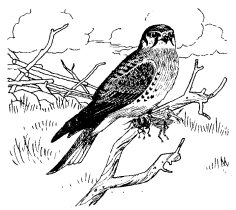
COOPER’S HAWK
| Online Library: | Title | Author | California | Geology | History | Indians | Muir | Mountaineering | Nature | Management |
Yosemite > Library > Birds of Yosemite > Hawk-like Birds >
Next: Fowl-like Birds • Contents • Previous: Goose-like Birds
TURKEY VULTURE (Cathartes aura): 2-2 1/2 ft. Upper parts blackish; under parts blackish-brown; under side of wings in area of primary and secondary feathers ash-gray; red, bare head; bill whitish; feet flesh-colored. Voice a low hiss, seldom uttered. Carrion feeder. Nests in cavities in cliffs or in hollow trees.
Uncommon R. in the Sierra Nevada, moving to foothills in winter. Has been observed as high as 10,000 feet on Mount Dana but more commonly seen at lower elevations.
GOSHAWK (Accipiter gentilis): 20-26 in. Above bluish-gray; top of head blackish; white line over eye; below white, streaked and waved with dusky; at a distance under parts appear light gray; black bars across tail; tip of tail edged with white. Female: Larger than male. Immature: Above brown; below streaked with brown on whitish; tail with dark crossbars and broadly tipped with white.
Nests from 5,000 to 9,000 feet in well-forested mountains. In summer associated with coniferous forests but when in the lowlands usually frequents broken woodland. R, in the Sierrta Nevada but often moves to lower elevations in winter. Recorded as nesting near Yosemite Valley.
SHARP-SHINNED HAWK (Accipiter striatus): 10-15 in. Resembles Cooper’s hawk but tail square-tipped, not rounded as in Cooper’s hawk. Female: Larger than male, resembling in size a male Cooper’s hawk from which it is distinguished with difficulty. Feeds largely on other birds.
Frequents deciduous or coniferous woodland in summer. Widespread W.V. at lower elevations. R. in Yosemite region, occasionally nesting in Yosemite Valley.

COOPER’S HAWK |
Frequents wooded streams and canyons both in mountains and lowlands. Permanent R. Nests in Yosemite region, including Yosemite Valley.
SWAINSON’S HAWK (Buteo swainsoni): 19-22 in, Light phase: Above dark brown; chin and throat whitish; breast often with broad band of reddish-brown; belly white; under parts of wings buff anteriorly; from above, tail gray, often with whitish base. Dark phase: General coloration dark brown, almost black, lighter on flight feathers and some reddish-brown on under parts; no rust in tail as in adult black phase of redtail. Female: Larger than male. In spring and fall migration may be seen in flocks, differing thus from most other hawks.
Frequents dry plains and woodland of foothills and valleys; occasionally in high mountains. An occasional S. V. to high elevations in Yosemite region.

RED-TAILED HAWK |
Widespread R. occurring from the lowlands to the mountains. Most common large soaring hawk in the Yosemite region; observed as high as 12,000 feet, at the summit of Parsons Peak.

MARSH HAWK (Female) |
Frequents salt and freshwater marshes and grassland from the lowlands to the Canadian life zone; chiefly W. V. and C. V. to Yosemite region.
BALD EAGLE (Haliaeetus leucocephalus): 30-36 in. Head and tail white; remaining plumage dark brown. Immature entirely dusky brown except sometimes for touches of whitish on wing lining (not at bases of primaries as in immature golden eagle) and, when approaching adult plumage, whitish at base of tail feathers; no well-defined dark band at tip of tail. To a considerable extent scavenging in habit, feeding on carrion and dead fish but also captures rabbits and rodents. Occasionally frightens the osprey into dropping its fish prey which is then taken by the eagle.
Frequents ocean shores, lake margins, and rivers for foraging and nesting but ranges widely over diverse terrain. Most likely to be seen at lower elevations in the Yosemite region. Reported as nesting at Bower Cave, Mariposa County.
GOLDEN EAGLE (Aquila chrysaetos): 30-40 in. Largest land bird of Yosemite region. Generally dark brown; head and neck tinged with, golden brown; when seen in flight from below, nearly uniformly dark brown; white at base of tail; tarsi fully feathered; feet greenish-yellow; bill bluish. Female: Larger than male. Immature: Ash-gray patch toward wingtip; tail white with tip broadly bordered with black. Feeds commonly on ground squirrels and rabbits.
R. throughout the Sierra Nevada. Commonly breeds in the Upper Sonoran and Transition life zones but occasionally to above timberline. Often seen soaring near rim of Yosemite Valley.

OSPREY |
Summer R., principally along the coast and on larger lakes. C. V. to Yosemite region; most likely to be seen at Hetch Hetchy and Lake Eleanor.

PRAIRIE FALCON |
Widely distributed R. but nowhere common. Frequents dry, open terrain end rocky ledges. Nests at lower elevations but wanders to above timberline in summer. C. V. to Yosemite region; observed at Yosemite Valley and in the high Sierra.

PEREGRINE FALCON |
Frequents cliffs. Widespread R. except in southeastern deserts. C. V. in Yosemite region. Sometimes seen near brink of Upper Yosemite Fall.

SPARROW HAWK |
Frequents open country such as plains, deserts, fields, and unforested hillsides. Uses dead trees, rocks, fence posts, telephone poles and wires as perches. R. at lower elevations; often ranges higher in mountains in summer. R. in Yosemite region where in summer it ranges as high as the Hudsonian life zone. To be seen about meadows in Yosemite Valley.
VULTURES, HAWKS and EAGLES

|
Next: Fowl-like Birds • Contents • Previous: Goose-like Birds
| Online Library: | Title | Author | California | Geology | History | Indians | Muir | Mountaineering | Nature | Management |
http://www.yosemite.ca.us/library/birds_of_yosemite/hawks.html